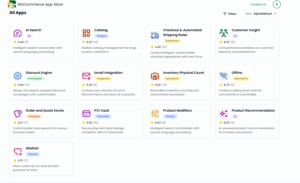It’s no simple task to market wholesale designer home décor items like decorative mirrors, vases and accent pieces via multiple sales channels to online and offline retailers, interior decorators and operators of hotels, restaurants and apartment buildings. AI is making it easier for distributor The Howard Elliott Collection.
And here’s the really good news: It didn’t take long to implement or cost a lot of money.
Howard Elliott gave technology provider WizCommerce the go-ahead to begin the project late last December, with a deadline to have a new AI-driven ecommerce site and related salesforce tools ready by the time of a big industry trade show in April. WizCommerce met the deadline and the new ecommerce site, which cost less than $50,000 to build, is already bringing in new customers, says Howard Elliott vice president Colleen Daly.

“Web order size is increasing by 10-15%,” Daly says. “We are also seeing leads convert to customers much faster than before. At this time, when a customer registers on the website, on average they are logged in and online within two hours of their approval and building a cart.”
The project’s quick turnaround and almost immediate results highlight how AI-focused startups like WizCommerce, which has raised $13.5 million in funding since its launch in 2021, are giving distributors new options as they try to get in on the artificial intelligence action. The Howard Elliott experience also shows how enthusiastic internal champions can help overcome employee resistance to adopting AI and other new technologies.
AI-enabled image recognition provides enhanced product recommendations
Daly says her goal was to replace Howard Elliott’s “clunky” ecommerce site that was turning off potential buyers with a better one that would be built and hosted by a tech provider. And she wanted improved sales tools for its independent sales reps and call center agents, such as one that could recommend similar products that are in stock.
“There are not a ton of those companies in our industry, and we didn’t want to work with two different resources,” she says. She liked that WizCommerce had experience working with companies that have similar manufacturing requirements—Howard Elliott, besides being a distributor, makes some items itself, such as decorative pillows—and that former employees from companies she’s worked with had gotten jobs at WizCommerce.
The ability of AI to recognize attributes in product images of the distributor’s 5,000 SKUs has played a part both in making the ecommerce site easier to shop and helping salespeople better serve customers, Daly says.
“The AI tool is grouping items together based on attributes,” Daly says. “So when someone views an item, they will see a ‘view similar’ flag that will show them similar items based on attributes. Previously, this was a step that we had to do at item set up. Now it is dynamic.” Salespeople, whether working with customers on the phone or in person also can use the search tool to find products customers ask about and show them only what’s available.
Another feature allows customers or interior designers to upload images of products they like and see similar items available from Howard Elliott. What’s nice is that the feature works even when the uploaded image is of a product that Howard Elliott doesn’t carry, Daly says.
She recently conducted a training session for designers at a retail chain customer and showed them how the feature works by taking a picture of a vase the retailer had on display that Howard Elliott does not carry and uploaded it to the Howard Elliott site.
“It’s not ours, but the AI is showing you everything we have that’s similar,” Daly says. “It’s a nice tool for a sales rep to say, ‘You’re selling this for this much. We have these items you can sell for XYZ more or less. So it’s a good tool for the salesforce as well.”
Daly says the image-recognition feature will also help salespeople when they’re visiting clients or at a trade show. If a customer likes a mirror that’s out of stock, she says, the tool will show them items in stock and available to purchase.

Interior designer Jenna Gaidusek raved about the new HowardElliott.com site recently when she hosted Howard Elliott marketing coordinator Bree Cassidy on her podcast, AI for Interior Designers. She praised Howard Elliott’s embrace of new technology and gushed about what she called the “reverse search” that lets people search by uploading images of products they like.
“I love your search feature on your website, the reverse image search that we even have access to, it’s so, like ‘Why wouldn’t we have that?’ You’re almost one of the first retailers or wholesalers that has that, that I’ve seen,” Gaidusek said.
Howard Elliott’s new ecommerce site wins new customers
Besides the higher average order value, another sign the new ecommerce site is generating new business is that each month 500 to 600 visitors are requesting user names and passwords so they can log into the site and potentially make purchases, Daly says. With the old website, perhaps 50 people would make that request each month, she says.
HowardElliott.com currently generates about 30% of the company’s revenue, though Daly says with the new site “we hope it will be better in the coming months.”
Daly and Cassidy also are excited about new features WizCommerce is developing.

One, launched in August, is a self-service portal that allows WizCommerce clients like Howard Elliott upload product images and photos of interiors to generate images that show a product in a particular setting. That way, for example, the site can show a mirror in a living room with traditional furniture to customers interested in that style and the same mirror in a contemporary setting for others.
Not only can the portal create photos, it can also create line drawings that show the dimensions of a product like a side table or cabinet.
Now Howard Elliott relies on several programs as well as outside vendors to create its images, and it can take a month to generate the imagery for a few dozen products, Cassidy says. “Having it all in one platform will save a lot of time,” she says.
Bringing customers back to activate accounts and purchase
Another tool WizCommerce is developing at Howard Elliott’s request will create automated reminder emails to site visitors that place items in the shopping cart but don’t complete the purchase. Daly says the aim is to generate emails that sound like they come from a human, not a bot.
“They will be personalized, not canned, to try and reengage them based on their sales history, the items they selected, maybe stock status,” she says.
Another project aims to create personalized emails to reactivate those among the 8,500 individuals who had accounts on the old website but haven’t created a new password so they can use the new site.
As befits a young company, WizCommerce is constantly adding new features. One introduced this spring is an AI-powered sales assistant called Kai designed to allow salespeople to get sales reports and lead suggestions, automate follow-ups and make customer-specific product recommendations.

Daly says it will allow a sales rep to log onto a portal to get information about customers, such as which ones have ordered at least 50 mirrors in the last six months. She says Howard Elliott plans to implement the feature once it uploads all its customer history data to the WizCommerce system.
Another recent WizCommerce offering is an app store that allows clients to see all the add-on features available and to purchase the ones they want. Daly and Cassidy say they like that they can select tools that fit their needs without paying for services that don’t.
Integrating AI with existing systems
For all the power of AI, it won’t do a company much good if employees aren’t willing to use it, and Daly and Cassidy say they have made good progress on that front, even if not everyone is yet using all the tools.
A recent Massachusetts Institute of Technology study on why AI projects frequently fail says a big issue is poor integration with existing systems, forcing employees to learn new procedures. The Howard Elliott executives gives WizCommerce high marks for largely avoiding that resistance by integrating its technology with the company’s “antiquated” Microsoft Dynamics GP (Great Plains) ERP system, which Microsoft plans to phase out by 2028, and its HubSpot marketing software.
“All the tools have been very easy to learn, very user-friendly,” Cassidy says.
In addition, Daly says it’s helped that she and Cassidy have aggressively made the case for the new technology to anyone who will listen.
“What’s making it easier to push is our excitement about it,” she says. “If don’t believe in these toosls we’re not going to sell it to anybody else. But, being excited about it, you want to show it off.”
Besides Cassidy appearing on the AI for Interior Designers podcast to talk up the new technology, Daly created a training video “showing off those features and tools we think are really cool.”
Nor does Daly rely on sales reps and other employees reading memos about how great the new system is. “Nobody will read about it, but if we take extra time in sales meetings to show them how to utilize these tools, they’re adopting them a lot faster,” Daly says.
Given that more than half of U.S. workers said they were worried about how AI would be used in the workplace in an October 2024 Pew Research Center survey, it makes sense for distributors implementing AI to take the time to explain to employees how the new technology will help them do their jobs and make more money, not put them out of work.
